Case Study Analysis: Joseph's CVAD Bloodstream Infection and Occlusion
VerifiedAdded on 2021/12/05
|10
|2509
|68
Case Study
AI Summary
This case study examines the health issues of Joseph, who was admitted to the hospital due to unresponsiveness and subsequently developed a central venous access device (CVAD)-associated bloodstream infection and occlusion. The study delves into the causes of the infection, emphasizing the role of aseptic techniques and potential sources of contamination. It explores the diagnosis and complications, including occlusion, and outlines action plans for the prevention and management of such infections. Management strategies discussed include thrombolytic agents, anticoagulants, and lifestyle adjustments such as diet and exercise. The study highlights the importance of strict protocols, hygiene practices, and ongoing monitoring to minimize infection risks and improve patient outcomes, concluding with a summary of the findings and recommendations for comprehensive patient care.

Running head: CASE STUDY OF JOSEPH
Case study of joseph
Name of the student:
Name of the university
Author note:
Case study of joseph
Name of the student:
Name of the university
Author note:
Paraphrase This Document
Need a fresh take? Get an instant paraphrase of this document with our AI Paraphraser
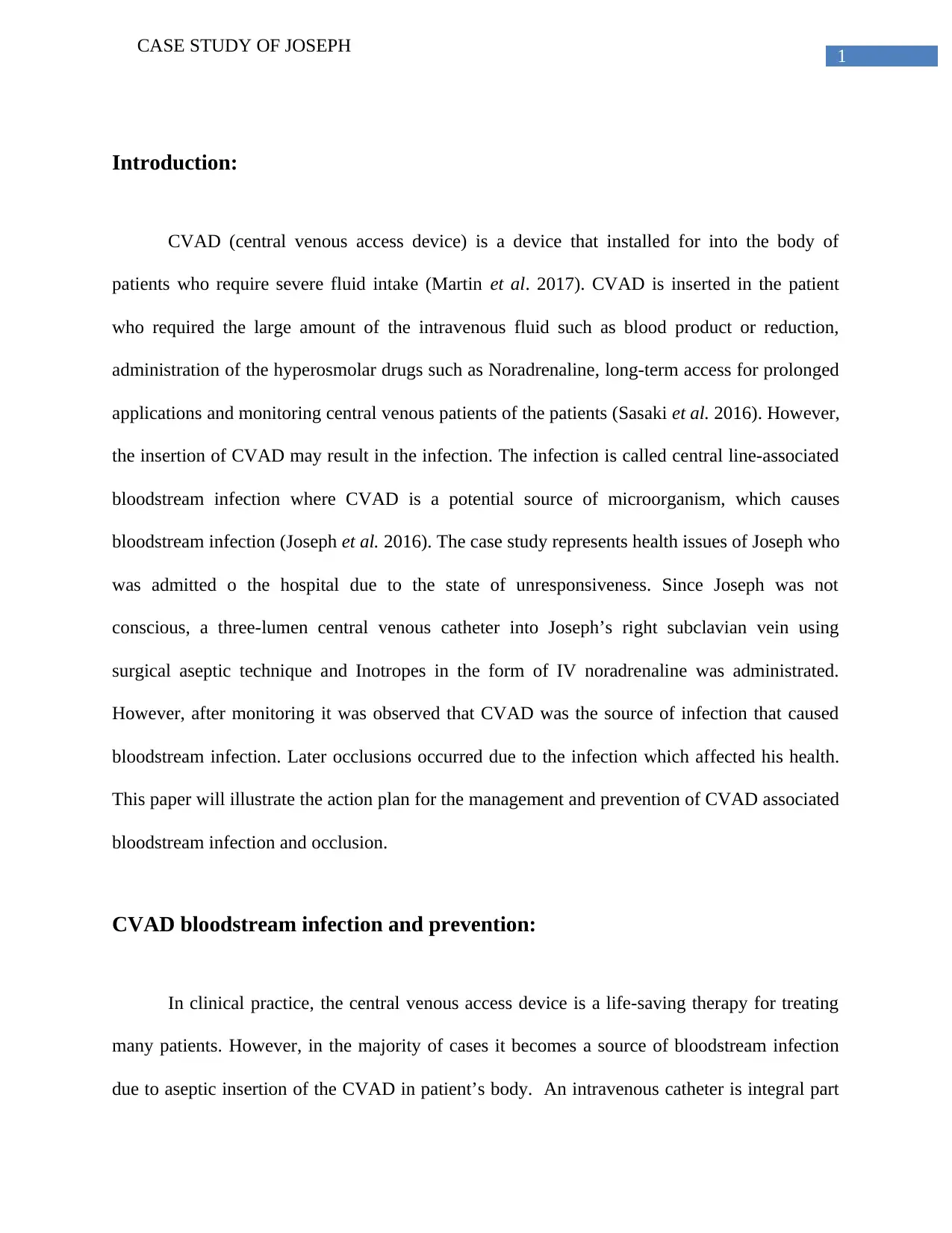
1
CASE STUDY OF JOSEPH
Introduction:
CVAD (central venous access device) is a device that installed for into the body of
patients who require severe fluid intake (Martin et al. 2017). CVAD is inserted in the patient
who required the large amount of the intravenous fluid such as blood product or reduction,
administration of the hyperosmolar drugs such as Noradrenaline, long-term access for prolonged
applications and monitoring central venous patients of the patients (Sasaki et al. 2016). However,
the insertion of CVAD may result in the infection. The infection is called central line-associated
bloodstream infection where CVAD is a potential source of microorganism, which causes
bloodstream infection (Joseph et al. 2016). The case study represents health issues of Joseph who
was admitted o the hospital due to the state of unresponsiveness. Since Joseph was not
conscious, a three-lumen central venous catheter into Joseph’s right subclavian vein using
surgical aseptic technique and Inotropes in the form of IV noradrenaline was administrated.
However, after monitoring it was observed that CVAD was the source of infection that caused
bloodstream infection. Later occlusions occurred due to the infection which affected his health.
This paper will illustrate the action plan for the management and prevention of CVAD associated
bloodstream infection and occlusion.
CVAD bloodstream infection and prevention:
In clinical practice, the central venous access device is a life-saving therapy for treating
many patients. However, in the majority of cases it becomes a source of bloodstream infection
due to aseptic insertion of the CVAD in patient’s body. An intravenous catheter is integral part
CASE STUDY OF JOSEPH
Introduction:
CVAD (central venous access device) is a device that installed for into the body of
patients who require severe fluid intake (Martin et al. 2017). CVAD is inserted in the patient
who required the large amount of the intravenous fluid such as blood product or reduction,
administration of the hyperosmolar drugs such as Noradrenaline, long-term access for prolonged
applications and monitoring central venous patients of the patients (Sasaki et al. 2016). However,
the insertion of CVAD may result in the infection. The infection is called central line-associated
bloodstream infection where CVAD is a potential source of microorganism, which causes
bloodstream infection (Joseph et al. 2016). The case study represents health issues of Joseph who
was admitted o the hospital due to the state of unresponsiveness. Since Joseph was not
conscious, a three-lumen central venous catheter into Joseph’s right subclavian vein using
surgical aseptic technique and Inotropes in the form of IV noradrenaline was administrated.
However, after monitoring it was observed that CVAD was the source of infection that caused
bloodstream infection. Later occlusions occurred due to the infection which affected his health.
This paper will illustrate the action plan for the management and prevention of CVAD associated
bloodstream infection and occlusion.
CVAD bloodstream infection and prevention:
In clinical practice, the central venous access device is a life-saving therapy for treating
many patients. However, in the majority of cases it becomes a source of bloodstream infection
due to aseptic insertion of the CVAD in patient’s body. An intravenous catheter is integral part
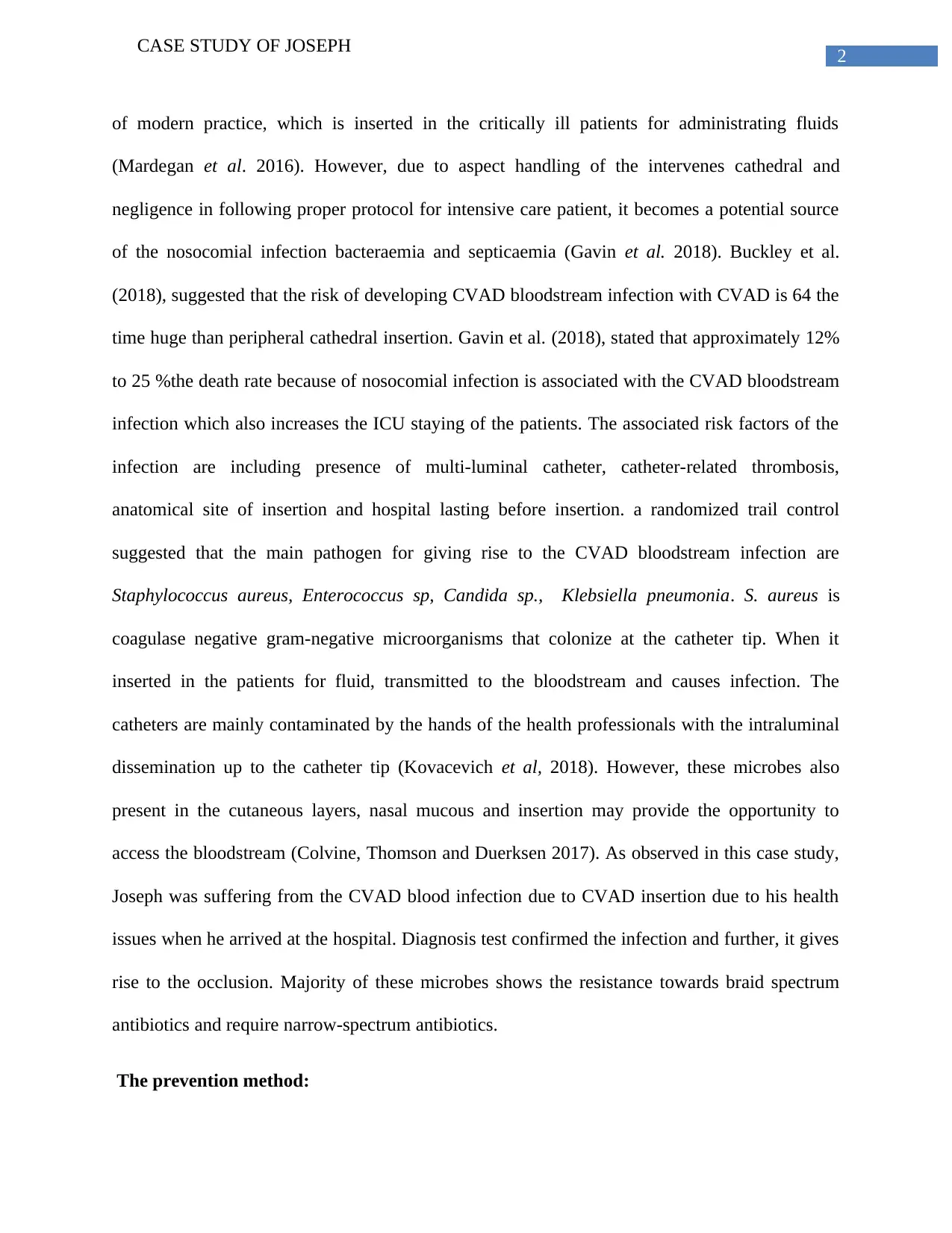
2
CASE STUDY OF JOSEPH
of modern practice, which is inserted in the critically ill patients for administrating fluids
(Mardegan et al. 2016). However, due to aspect handling of the intervenes cathedral and
negligence in following proper protocol for intensive care patient, it becomes a potential source
of the nosocomial infection bacteraemia and septicaemia (Gavin et al. 2018). Buckley et al.
(2018), suggested that the risk of developing CVAD bloodstream infection with CVAD is 64 the
time huge than peripheral cathedral insertion. Gavin et al. (2018), stated that approximately 12%
to 25 %the death rate because of nosocomial infection is associated with the CVAD bloodstream
infection which also increases the ICU staying of the patients. The associated risk factors of the
infection are including presence of multi-luminal catheter, catheter-related thrombosis,
anatomical site of insertion and hospital lasting before insertion. a randomized trail control
suggested that the main pathogen for giving rise to the CVAD bloodstream infection are
Staphylococcus aureus, Enterococcus sp, Candida sp., Klebsiella pneumonia. S. aureus is
coagulase negative gram-negative microorganisms that colonize at the catheter tip. When it
inserted in the patients for fluid, transmitted to the bloodstream and causes infection. The
catheters are mainly contaminated by the hands of the health professionals with the intraluminal
dissemination up to the catheter tip (Kovacevich et al, 2018). However, these microbes also
present in the cutaneous layers, nasal mucous and insertion may provide the opportunity to
access the bloodstream (Colvine, Thomson and Duerksen 2017). As observed in this case study,
Joseph was suffering from the CVAD blood infection due to CVAD insertion due to his health
issues when he arrived at the hospital. Diagnosis test confirmed the infection and further, it gives
rise to the occlusion. Majority of these microbes shows the resistance towards braid spectrum
antibiotics and require narrow-spectrum antibiotics.
The prevention method:
CASE STUDY OF JOSEPH
of modern practice, which is inserted in the critically ill patients for administrating fluids
(Mardegan et al. 2016). However, due to aspect handling of the intervenes cathedral and
negligence in following proper protocol for intensive care patient, it becomes a potential source
of the nosocomial infection bacteraemia and septicaemia (Gavin et al. 2018). Buckley et al.
(2018), suggested that the risk of developing CVAD bloodstream infection with CVAD is 64 the
time huge than peripheral cathedral insertion. Gavin et al. (2018), stated that approximately 12%
to 25 %the death rate because of nosocomial infection is associated with the CVAD bloodstream
infection which also increases the ICU staying of the patients. The associated risk factors of the
infection are including presence of multi-luminal catheter, catheter-related thrombosis,
anatomical site of insertion and hospital lasting before insertion. a randomized trail control
suggested that the main pathogen for giving rise to the CVAD bloodstream infection are
Staphylococcus aureus, Enterococcus sp, Candida sp., Klebsiella pneumonia. S. aureus is
coagulase negative gram-negative microorganisms that colonize at the catheter tip. When it
inserted in the patients for fluid, transmitted to the bloodstream and causes infection. The
catheters are mainly contaminated by the hands of the health professionals with the intraluminal
dissemination up to the catheter tip (Kovacevich et al, 2018). However, these microbes also
present in the cutaneous layers, nasal mucous and insertion may provide the opportunity to
access the bloodstream (Colvine, Thomson and Duerksen 2017). As observed in this case study,
Joseph was suffering from the CVAD blood infection due to CVAD insertion due to his health
issues when he arrived at the hospital. Diagnosis test confirmed the infection and further, it gives
rise to the occlusion. Majority of these microbes shows the resistance towards braid spectrum
antibiotics and require narrow-spectrum antibiotics.
The prevention method:
⊘ This is a preview!⊘
Do you want full access?
Subscribe today to unlock all pages.

Trusted by 1+ million students worldwide
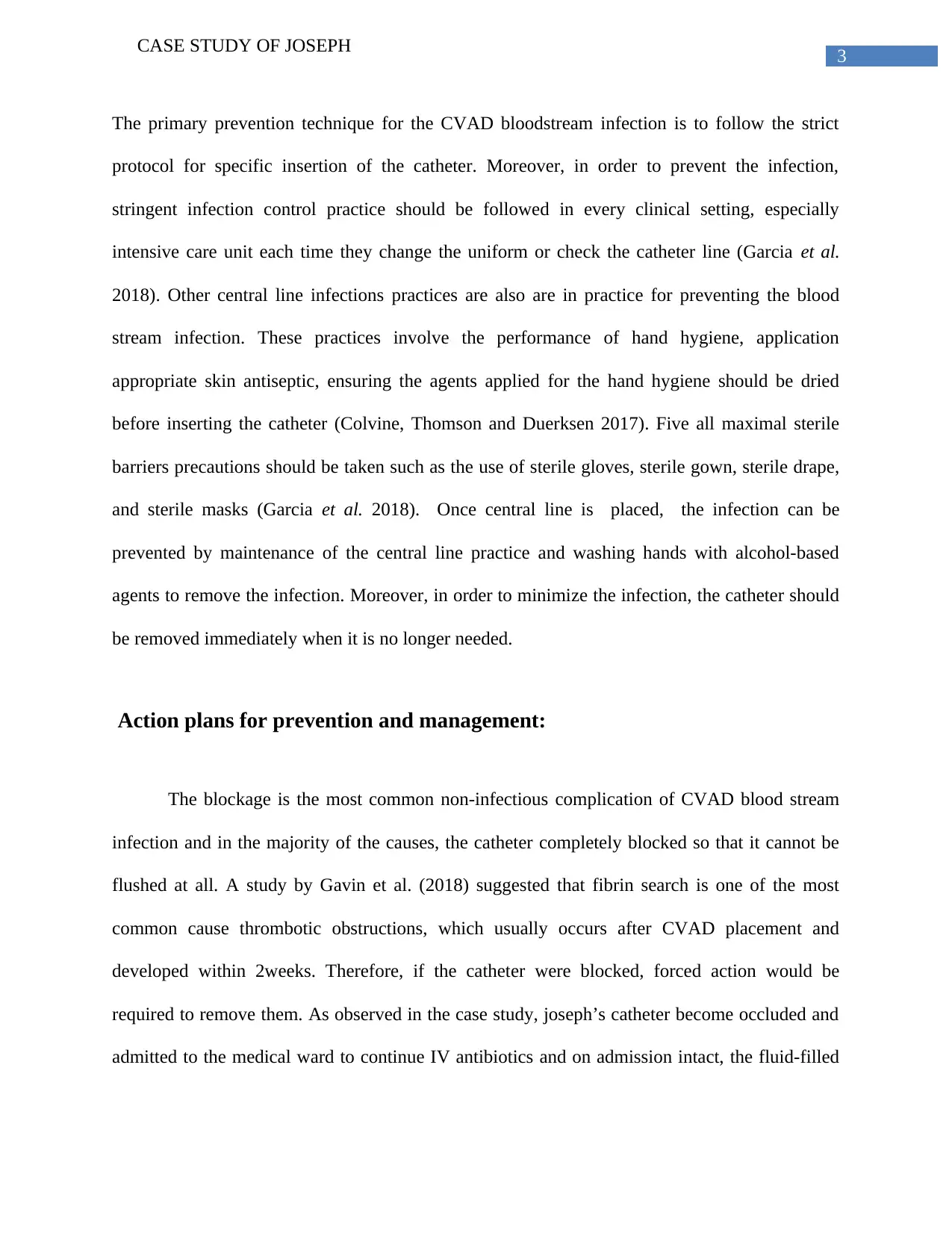
3
CASE STUDY OF JOSEPH
The primary prevention technique for the CVAD bloodstream infection is to follow the strict
protocol for specific insertion of the catheter. Moreover, in order to prevent the infection,
stringent infection control practice should be followed in every clinical setting, especially
intensive care unit each time they change the uniform or check the catheter line (Garcia et al.
2018). Other central line infections practices are also are in practice for preventing the blood
stream infection. These practices involve the performance of hand hygiene, application
appropriate skin antiseptic, ensuring the agents applied for the hand hygiene should be dried
before inserting the catheter (Colvine, Thomson and Duerksen 2017). Five all maximal sterile
barriers precautions should be taken such as the use of sterile gloves, sterile gown, sterile drape,
and sterile masks (Garcia et al. 2018). Once central line is placed, the infection can be
prevented by maintenance of the central line practice and washing hands with alcohol-based
agents to remove the infection. Moreover, in order to minimize the infection, the catheter should
be removed immediately when it is no longer needed.
Action plans for prevention and management:
The blockage is the most common non-infectious complication of CVAD blood stream
infection and in the majority of the causes, the catheter completely blocked so that it cannot be
flushed at all. A study by Gavin et al. (2018) suggested that fibrin search is one of the most
common cause thrombotic obstructions, which usually occurs after CVAD placement and
developed within 2weeks. Therefore, if the catheter were blocked, forced action would be
required to remove them. As observed in the case study, joseph’s catheter become occluded and
admitted to the medical ward to continue IV antibiotics and on admission intact, the fluid-filled
CASE STUDY OF JOSEPH
The primary prevention technique for the CVAD bloodstream infection is to follow the strict
protocol for specific insertion of the catheter. Moreover, in order to prevent the infection,
stringent infection control practice should be followed in every clinical setting, especially
intensive care unit each time they change the uniform or check the catheter line (Garcia et al.
2018). Other central line infections practices are also are in practice for preventing the blood
stream infection. These practices involve the performance of hand hygiene, application
appropriate skin antiseptic, ensuring the agents applied for the hand hygiene should be dried
before inserting the catheter (Colvine, Thomson and Duerksen 2017). Five all maximal sterile
barriers precautions should be taken such as the use of sterile gloves, sterile gown, sterile drape,
and sterile masks (Garcia et al. 2018). Once central line is placed, the infection can be
prevented by maintenance of the central line practice and washing hands with alcohol-based
agents to remove the infection. Moreover, in order to minimize the infection, the catheter should
be removed immediately when it is no longer needed.
Action plans for prevention and management:
The blockage is the most common non-infectious complication of CVAD blood stream
infection and in the majority of the causes, the catheter completely blocked so that it cannot be
flushed at all. A study by Gavin et al. (2018) suggested that fibrin search is one of the most
common cause thrombotic obstructions, which usually occurs after CVAD placement and
developed within 2weeks. Therefore, if the catheter were blocked, forced action would be
required to remove them. As observed in the case study, joseph’s catheter become occluded and
admitted to the medical ward to continue IV antibiotics and on admission intact, the fluid-filled
Paraphrase This Document
Need a fresh take? Get an instant paraphrase of this document with our AI Paraphraser
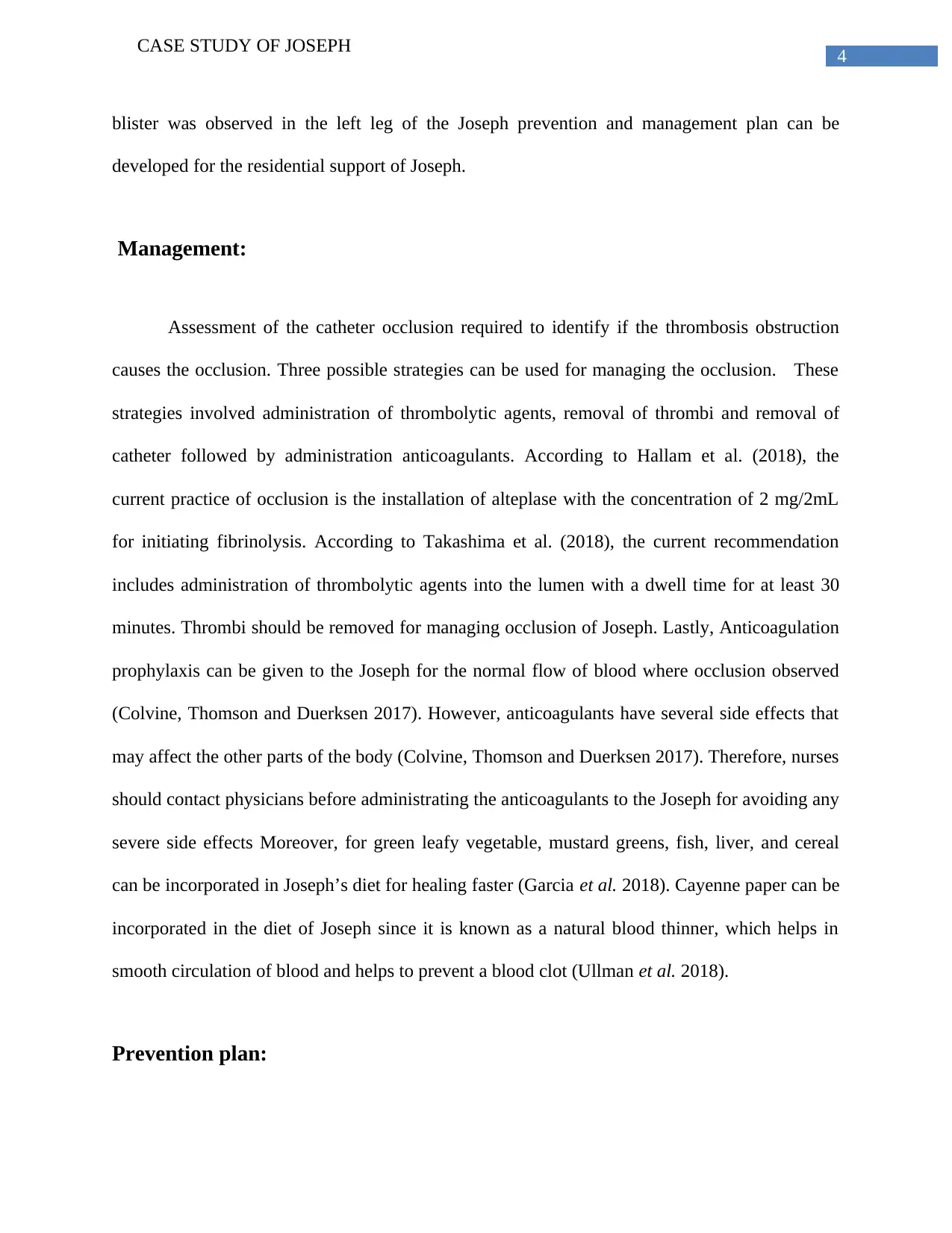
4
CASE STUDY OF JOSEPH
blister was observed in the left leg of the Joseph prevention and management plan can be
developed for the residential support of Joseph.
Management:
Assessment of the catheter occlusion required to identify if the thrombosis obstruction
causes the occlusion. Three possible strategies can be used for managing the occlusion. These
strategies involved administration of thrombolytic agents, removal of thrombi and removal of
catheter followed by administration anticoagulants. According to Hallam et al. (2018), the
current practice of occlusion is the installation of alteplase with the concentration of 2 mg/2mL
for initiating fibrinolysis. According to Takashima et al. (2018), the current recommendation
includes administration of thrombolytic agents into the lumen with a dwell time for at least 30
minutes. Thrombi should be removed for managing occlusion of Joseph. Lastly, Anticoagulation
prophylaxis can be given to the Joseph for the normal flow of blood where occlusion observed
(Colvine, Thomson and Duerksen 2017). However, anticoagulants have several side effects that
may affect the other parts of the body (Colvine, Thomson and Duerksen 2017). Therefore, nurses
should contact physicians before administrating the anticoagulants to the Joseph for avoiding any
severe side effects Moreover, for green leafy vegetable, mustard greens, fish, liver, and cereal
can be incorporated in Joseph’s diet for healing faster (Garcia et al. 2018). Cayenne paper can be
incorporated in the diet of Joseph since it is known as a natural blood thinner, which helps in
smooth circulation of blood and helps to prevent a blood clot (Ullman et al. 2018).
Prevention plan:
CASE STUDY OF JOSEPH
blister was observed in the left leg of the Joseph prevention and management plan can be
developed for the residential support of Joseph.
Management:
Assessment of the catheter occlusion required to identify if the thrombosis obstruction
causes the occlusion. Three possible strategies can be used for managing the occlusion. These
strategies involved administration of thrombolytic agents, removal of thrombi and removal of
catheter followed by administration anticoagulants. According to Hallam et al. (2018), the
current practice of occlusion is the installation of alteplase with the concentration of 2 mg/2mL
for initiating fibrinolysis. According to Takashima et al. (2018), the current recommendation
includes administration of thrombolytic agents into the lumen with a dwell time for at least 30
minutes. Thrombi should be removed for managing occlusion of Joseph. Lastly, Anticoagulation
prophylaxis can be given to the Joseph for the normal flow of blood where occlusion observed
(Colvine, Thomson and Duerksen 2017). However, anticoagulants have several side effects that
may affect the other parts of the body (Colvine, Thomson and Duerksen 2017). Therefore, nurses
should contact physicians before administrating the anticoagulants to the Joseph for avoiding any
severe side effects Moreover, for green leafy vegetable, mustard greens, fish, liver, and cereal
can be incorporated in Joseph’s diet for healing faster (Garcia et al. 2018). Cayenne paper can be
incorporated in the diet of Joseph since it is known as a natural blood thinner, which helps in
smooth circulation of blood and helps to prevent a blood clot (Ullman et al. 2018).
Prevention plan:
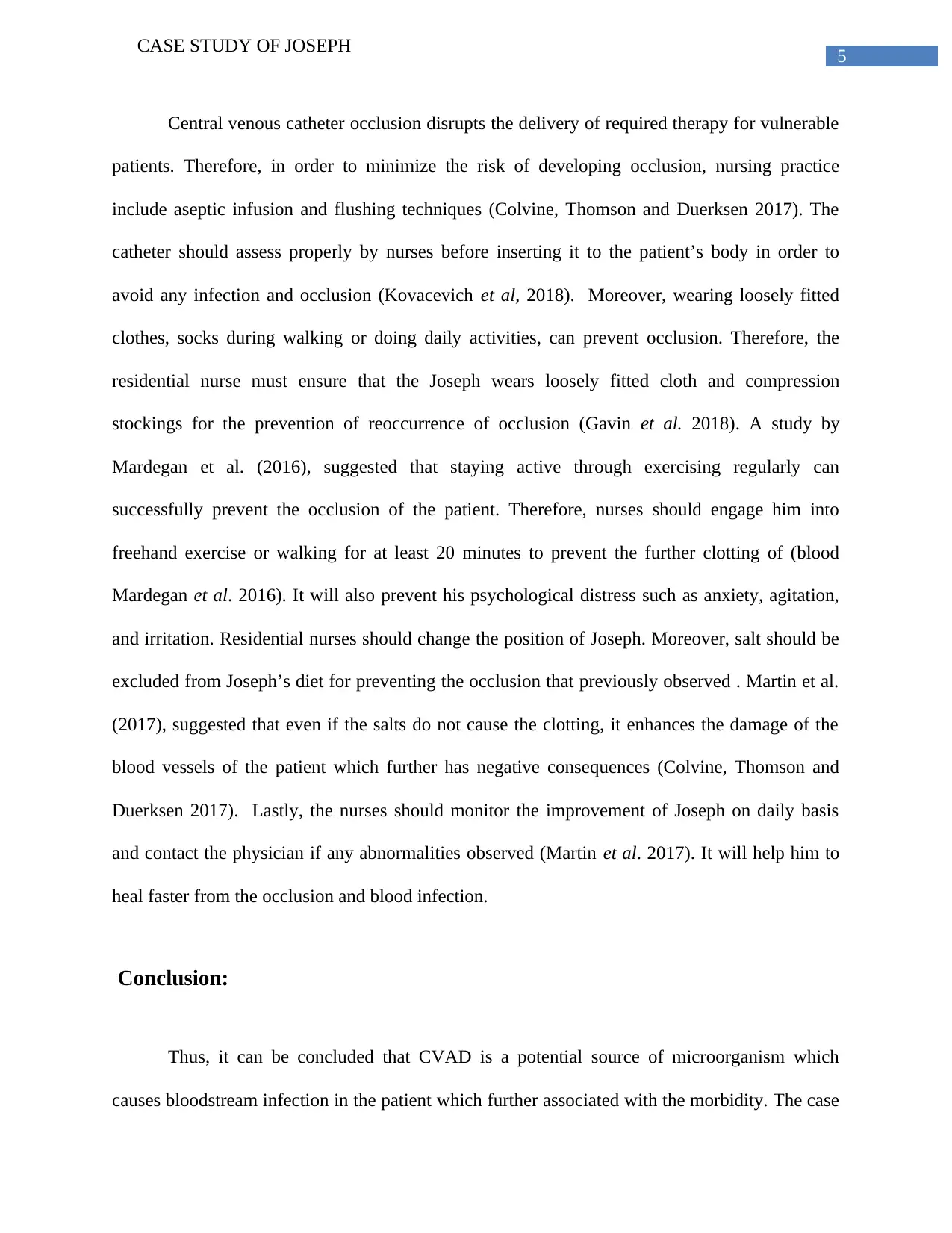
5
CASE STUDY OF JOSEPH
Central venous catheter occlusion disrupts the delivery of required therapy for vulnerable
patients. Therefore, in order to minimize the risk of developing occlusion, nursing practice
include aseptic infusion and flushing techniques (Colvine, Thomson and Duerksen 2017). The
catheter should assess properly by nurses before inserting it to the patient’s body in order to
avoid any infection and occlusion (Kovacevich et al, 2018). Moreover, wearing loosely fitted
clothes, socks during walking or doing daily activities, can prevent occlusion. Therefore, the
residential nurse must ensure that the Joseph wears loosely fitted cloth and compression
stockings for the prevention of reoccurrence of occlusion (Gavin et al. 2018). A study by
Mardegan et al. (2016), suggested that staying active through exercising regularly can
successfully prevent the occlusion of the patient. Therefore, nurses should engage him into
freehand exercise or walking for at least 20 minutes to prevent the further clotting of (blood
Mardegan et al. 2016). It will also prevent his psychological distress such as anxiety, agitation,
and irritation. Residential nurses should change the position of Joseph. Moreover, salt should be
excluded from Joseph’s diet for preventing the occlusion that previously observed . Martin et al.
(2017), suggested that even if the salts do not cause the clotting, it enhances the damage of the
blood vessels of the patient which further has negative consequences (Colvine, Thomson and
Duerksen 2017). Lastly, the nurses should monitor the improvement of Joseph on daily basis
and contact the physician if any abnormalities observed (Martin et al. 2017). It will help him to
heal faster from the occlusion and blood infection.
Conclusion:
Thus, it can be concluded that CVAD is a potential source of microorganism which
causes bloodstream infection in the patient which further associated with the morbidity. The case
CASE STUDY OF JOSEPH
Central venous catheter occlusion disrupts the delivery of required therapy for vulnerable
patients. Therefore, in order to minimize the risk of developing occlusion, nursing practice
include aseptic infusion and flushing techniques (Colvine, Thomson and Duerksen 2017). The
catheter should assess properly by nurses before inserting it to the patient’s body in order to
avoid any infection and occlusion (Kovacevich et al, 2018). Moreover, wearing loosely fitted
clothes, socks during walking or doing daily activities, can prevent occlusion. Therefore, the
residential nurse must ensure that the Joseph wears loosely fitted cloth and compression
stockings for the prevention of reoccurrence of occlusion (Gavin et al. 2018). A study by
Mardegan et al. (2016), suggested that staying active through exercising regularly can
successfully prevent the occlusion of the patient. Therefore, nurses should engage him into
freehand exercise or walking for at least 20 minutes to prevent the further clotting of (blood
Mardegan et al. 2016). It will also prevent his psychological distress such as anxiety, agitation,
and irritation. Residential nurses should change the position of Joseph. Moreover, salt should be
excluded from Joseph’s diet for preventing the occlusion that previously observed . Martin et al.
(2017), suggested that even if the salts do not cause the clotting, it enhances the damage of the
blood vessels of the patient which further has negative consequences (Colvine, Thomson and
Duerksen 2017). Lastly, the nurses should monitor the improvement of Joseph on daily basis
and contact the physician if any abnormalities observed (Martin et al. 2017). It will help him to
heal faster from the occlusion and blood infection.
Conclusion:
Thus, it can be concluded that CVAD is a potential source of microorganism which
causes bloodstream infection in the patient which further associated with the morbidity. The case
⊘ This is a preview!⊘
Do you want full access?
Subscribe today to unlock all pages.

Trusted by 1+ million students worldwide
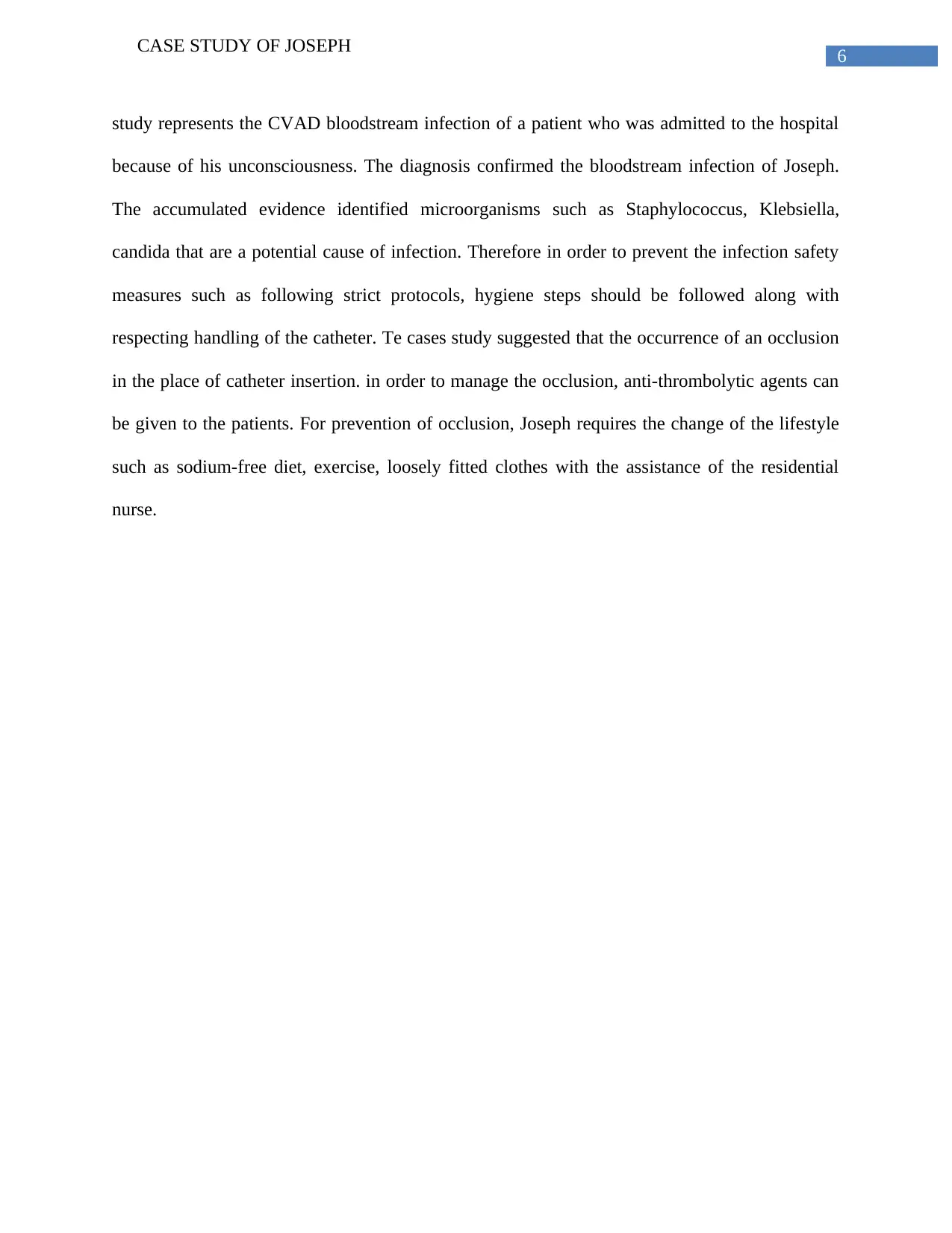
6
CASE STUDY OF JOSEPH
study represents the CVAD bloodstream infection of a patient who was admitted to the hospital
because of his unconsciousness. The diagnosis confirmed the bloodstream infection of Joseph.
The accumulated evidence identified microorganisms such as Staphylococcus, Klebsiella,
candida that are a potential cause of infection. Therefore in order to prevent the infection safety
measures such as following strict protocols, hygiene steps should be followed along with
respecting handling of the catheter. Te cases study suggested that the occurrence of an occlusion
in the place of catheter insertion. in order to manage the occlusion, anti-thrombolytic agents can
be given to the patients. For prevention of occlusion, Joseph requires the change of the lifestyle
such as sodium-free diet, exercise, loosely fitted clothes with the assistance of the residential
nurse.
CASE STUDY OF JOSEPH
study represents the CVAD bloodstream infection of a patient who was admitted to the hospital
because of his unconsciousness. The diagnosis confirmed the bloodstream infection of Joseph.
The accumulated evidence identified microorganisms such as Staphylococcus, Klebsiella,
candida that are a potential cause of infection. Therefore in order to prevent the infection safety
measures such as following strict protocols, hygiene steps should be followed along with
respecting handling of the catheter. Te cases study suggested that the occurrence of an occlusion
in the place of catheter insertion. in order to manage the occlusion, anti-thrombolytic agents can
be given to the patients. For prevention of occlusion, Joseph requires the change of the lifestyle
such as sodium-free diet, exercise, loosely fitted clothes with the assistance of the residential
nurse.
Paraphrase This Document
Need a fresh take? Get an instant paraphrase of this document with our AI Paraphraser
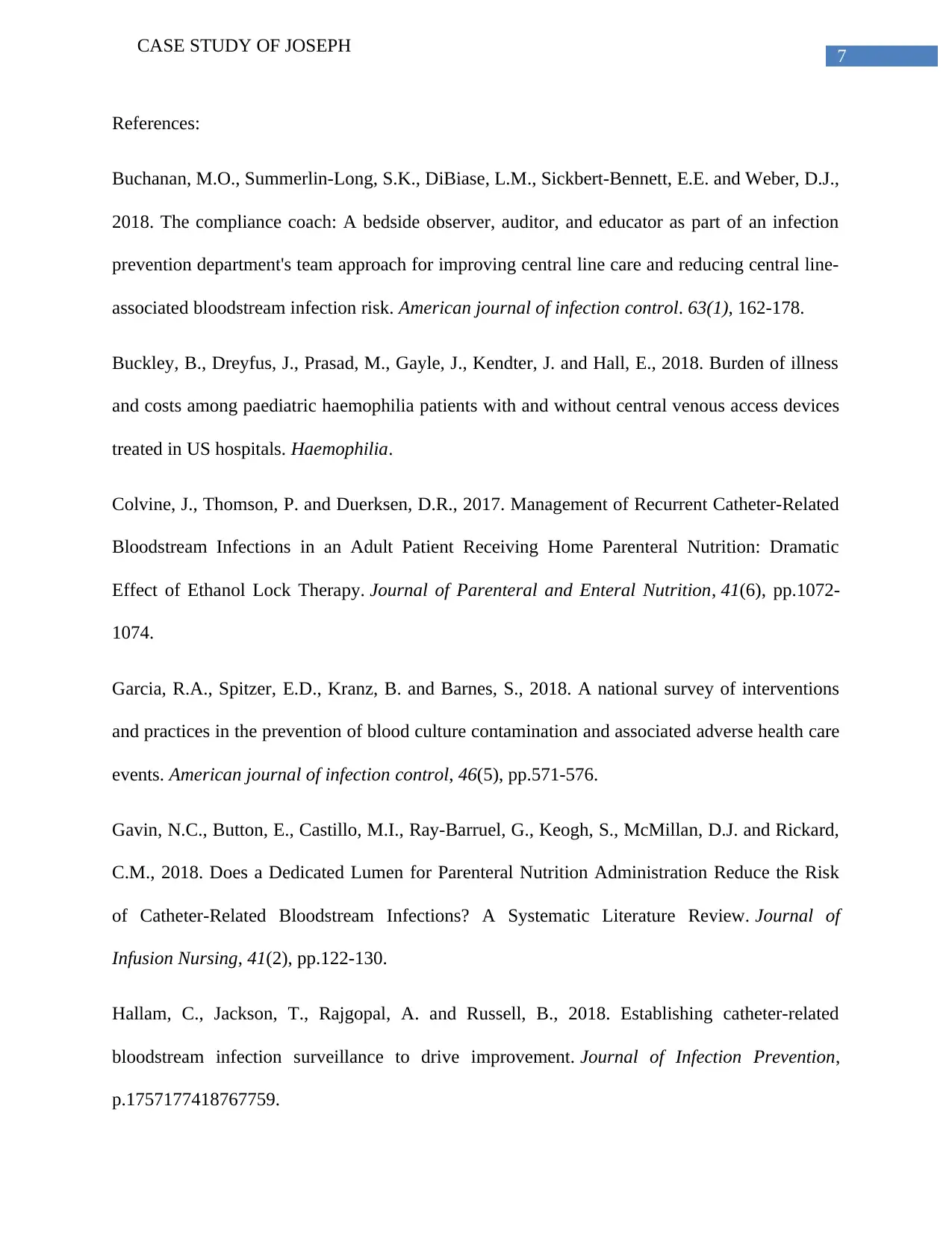
7
CASE STUDY OF JOSEPH
References:
Buchanan, M.O., Summerlin-Long, S.K., DiBiase, L.M., Sickbert-Bennett, E.E. and Weber, D.J.,
2018. The compliance coach: A bedside observer, auditor, and educator as part of an infection
prevention department's team approach for improving central line care and reducing central line-
associated bloodstream infection risk. American journal of infection control. 63(1), 162-178.
Buckley, B., Dreyfus, J., Prasad, M., Gayle, J., Kendter, J. and Hall, E., 2018. Burden of illness
and costs among paediatric haemophilia patients with and without central venous access devices
treated in US hospitals. Haemophilia.
Colvine, J., Thomson, P. and Duerksen, D.R., 2017. Management of Recurrent Catheter‐Related
Bloodstream Infections in an Adult Patient Receiving Home Parenteral Nutrition: Dramatic
Effect of Ethanol Lock Therapy. Journal of Parenteral and Enteral Nutrition, 41(6), pp.1072-
1074.
Garcia, R.A., Spitzer, E.D., Kranz, B. and Barnes, S., 2018. A national survey of interventions
and practices in the prevention of blood culture contamination and associated adverse health care
events. American journal of infection control, 46(5), pp.571-576.
Gavin, N.C., Button, E., Castillo, M.I., Ray-Barruel, G., Keogh, S., McMillan, D.J. and Rickard,
C.M., 2018. Does a Dedicated Lumen for Parenteral Nutrition Administration Reduce the Risk
of Catheter-Related Bloodstream Infections? A Systematic Literature Review. Journal of
Infusion Nursing, 41(2), pp.122-130.
Hallam, C., Jackson, T., Rajgopal, A. and Russell, B., 2018. Establishing catheter-related
bloodstream infection surveillance to drive improvement. Journal of Infection Prevention,
p.1757177418767759.
CASE STUDY OF JOSEPH
References:
Buchanan, M.O., Summerlin-Long, S.K., DiBiase, L.M., Sickbert-Bennett, E.E. and Weber, D.J.,
2018. The compliance coach: A bedside observer, auditor, and educator as part of an infection
prevention department's team approach for improving central line care and reducing central line-
associated bloodstream infection risk. American journal of infection control. 63(1), 162-178.
Buckley, B., Dreyfus, J., Prasad, M., Gayle, J., Kendter, J. and Hall, E., 2018. Burden of illness
and costs among paediatric haemophilia patients with and without central venous access devices
treated in US hospitals. Haemophilia.
Colvine, J., Thomson, P. and Duerksen, D.R., 2017. Management of Recurrent Catheter‐Related
Bloodstream Infections in an Adult Patient Receiving Home Parenteral Nutrition: Dramatic
Effect of Ethanol Lock Therapy. Journal of Parenteral and Enteral Nutrition, 41(6), pp.1072-
1074.
Garcia, R.A., Spitzer, E.D., Kranz, B. and Barnes, S., 2018. A national survey of interventions
and practices in the prevention of blood culture contamination and associated adverse health care
events. American journal of infection control, 46(5), pp.571-576.
Gavin, N.C., Button, E., Castillo, M.I., Ray-Barruel, G., Keogh, S., McMillan, D.J. and Rickard,
C.M., 2018. Does a Dedicated Lumen for Parenteral Nutrition Administration Reduce the Risk
of Catheter-Related Bloodstream Infections? A Systematic Literature Review. Journal of
Infusion Nursing, 41(2), pp.122-130.
Hallam, C., Jackson, T., Rajgopal, A. and Russell, B., 2018. Establishing catheter-related
bloodstream infection surveillance to drive improvement. Journal of Infection Prevention,
p.1757177418767759.
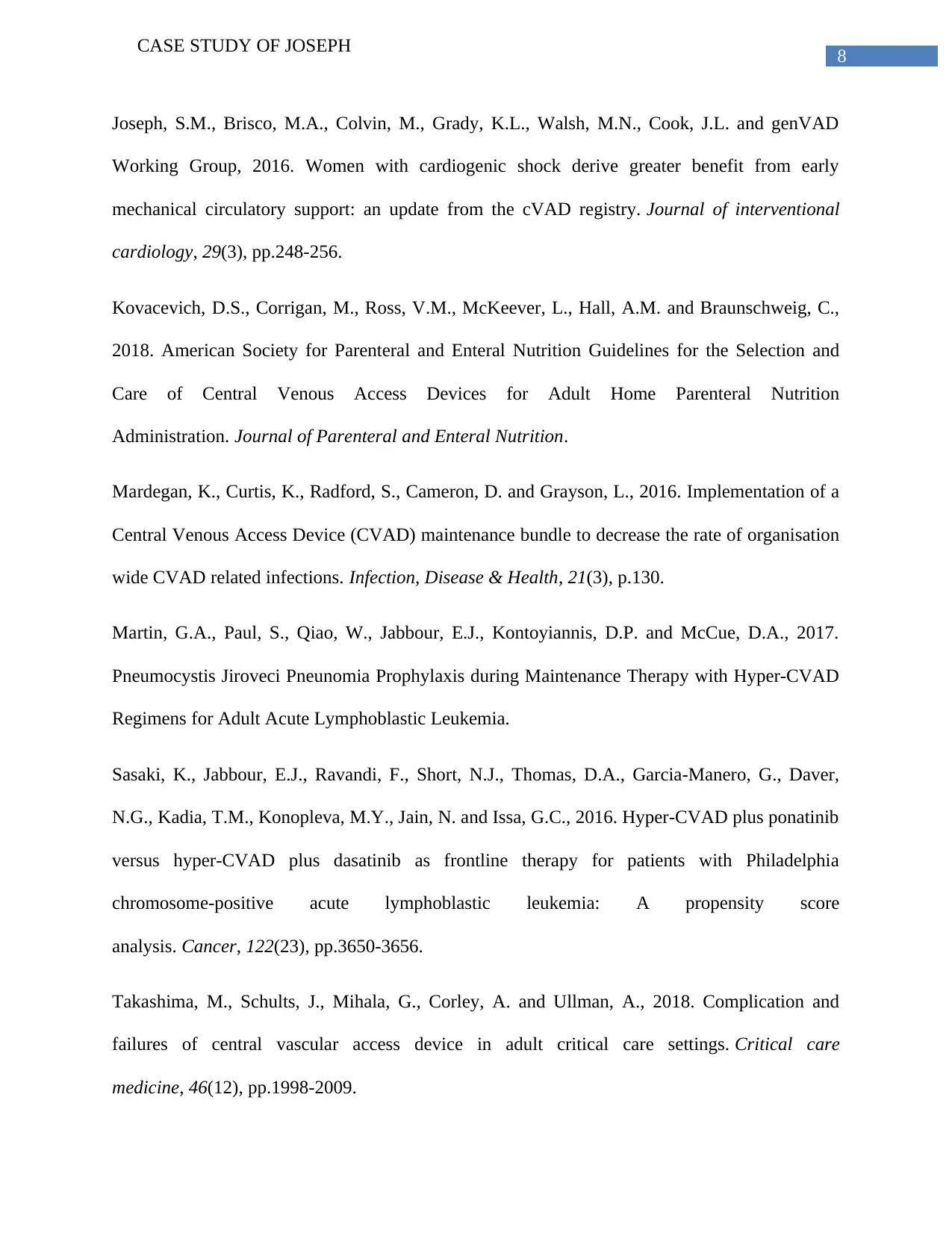
8
CASE STUDY OF JOSEPH
Joseph, S.M., Brisco, M.A., Colvin, M., Grady, K.L., Walsh, M.N., Cook, J.L. and genVAD
Working Group, 2016. Women with cardiogenic shock derive greater benefit from early
mechanical circulatory support: an update from the cVAD registry. Journal of interventional
cardiology, 29(3), pp.248-256.
Kovacevich, D.S., Corrigan, M., Ross, V.M., McKeever, L., Hall, A.M. and Braunschweig, C.,
2018. American Society for Parenteral and Enteral Nutrition Guidelines for the Selection and
Care of Central Venous Access Devices for Adult Home Parenteral Nutrition
Administration. Journal of Parenteral and Enteral Nutrition.
Mardegan, K., Curtis, K., Radford, S., Cameron, D. and Grayson, L., 2016. Implementation of a
Central Venous Access Device (CVAD) maintenance bundle to decrease the rate of organisation
wide CVAD related infections. Infection, Disease & Health, 21(3), p.130.
Martin, G.A., Paul, S., Qiao, W., Jabbour, E.J., Kontoyiannis, D.P. and McCue, D.A., 2017.
Pneumocystis Jiroveci Pneunomia Prophylaxis during Maintenance Therapy with Hyper-CVAD
Regimens for Adult Acute Lymphoblastic Leukemia.
Sasaki, K., Jabbour, E.J., Ravandi, F., Short, N.J., Thomas, D.A., Garcia‐Manero, G., Daver,
N.G., Kadia, T.M., Konopleva, M.Y., Jain, N. and Issa, G.C., 2016. Hyper‐CVAD plus ponatinib
versus hyper‐CVAD plus dasatinib as frontline therapy for patients with Philadelphia
chromosome‐positive acute lymphoblastic leukemia: A propensity score
analysis. Cancer, 122(23), pp.3650-3656.
Takashima, M., Schults, J., Mihala, G., Corley, A. and Ullman, A., 2018. Complication and
failures of central vascular access device in adult critical care settings. Critical care
medicine, 46(12), pp.1998-2009.
CASE STUDY OF JOSEPH
Joseph, S.M., Brisco, M.A., Colvin, M., Grady, K.L., Walsh, M.N., Cook, J.L. and genVAD
Working Group, 2016. Women with cardiogenic shock derive greater benefit from early
mechanical circulatory support: an update from the cVAD registry. Journal of interventional
cardiology, 29(3), pp.248-256.
Kovacevich, D.S., Corrigan, M., Ross, V.M., McKeever, L., Hall, A.M. and Braunschweig, C.,
2018. American Society for Parenteral and Enteral Nutrition Guidelines for the Selection and
Care of Central Venous Access Devices for Adult Home Parenteral Nutrition
Administration. Journal of Parenteral and Enteral Nutrition.
Mardegan, K., Curtis, K., Radford, S., Cameron, D. and Grayson, L., 2016. Implementation of a
Central Venous Access Device (CVAD) maintenance bundle to decrease the rate of organisation
wide CVAD related infections. Infection, Disease & Health, 21(3), p.130.
Martin, G.A., Paul, S., Qiao, W., Jabbour, E.J., Kontoyiannis, D.P. and McCue, D.A., 2017.
Pneumocystis Jiroveci Pneunomia Prophylaxis during Maintenance Therapy with Hyper-CVAD
Regimens for Adult Acute Lymphoblastic Leukemia.
Sasaki, K., Jabbour, E.J., Ravandi, F., Short, N.J., Thomas, D.A., Garcia‐Manero, G., Daver,
N.G., Kadia, T.M., Konopleva, M.Y., Jain, N. and Issa, G.C., 2016. Hyper‐CVAD plus ponatinib
versus hyper‐CVAD plus dasatinib as frontline therapy for patients with Philadelphia
chromosome‐positive acute lymphoblastic leukemia: A propensity score
analysis. Cancer, 122(23), pp.3650-3656.
Takashima, M., Schults, J., Mihala, G., Corley, A. and Ullman, A., 2018. Complication and
failures of central vascular access device in adult critical care settings. Critical care
medicine, 46(12), pp.1998-2009.
⊘ This is a preview!⊘
Do you want full access?
Subscribe today to unlock all pages.

Trusted by 1+ million students worldwide

9
CASE STUDY OF JOSEPH
Ullman, A.J., Cooke, M.L., Mitchell, M., Lin, F., New, K., Long, D.A., Mihala, G. and Rickard,
C.M., 2016. Dressing and securement for central venous access devices (CVADs): A Cochrane
systematic review. International journal of nursing studies, 59, pp.177-196.
CASE STUDY OF JOSEPH
Ullman, A.J., Cooke, M.L., Mitchell, M., Lin, F., New, K., Long, D.A., Mihala, G. and Rickard,
C.M., 2016. Dressing and securement for central venous access devices (CVADs): A Cochrane
systematic review. International journal of nursing studies, 59, pp.177-196.
1 out of 10
Related Documents
Your All-in-One AI-Powered Toolkit for Academic Success.
+13062052269
info@desklib.com
Available 24*7 on WhatsApp / Email
![[object Object]](/_next/static/media/star-bottom.7253800d.svg)
Unlock your academic potential
Copyright © 2020–2025 A2Z Services. All Rights Reserved. Developed and managed by ZUCOL.





